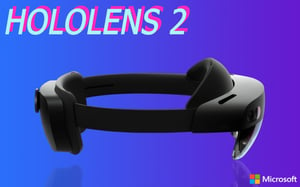
Microsoft HoloLens 2 | Features and improvements
Microsoft HoloLens 2 |
Functions and improvements
In 2016, Microsoft launched the HoloLens mixed reality glasses on the market for the first time, followed three years later by its successor, the Microsoft HoloLens 2. The head-mounted display (HMD) has a new design, but it's not just the look that has changed.
Bitnamic presents the most important functions and significant improvements of the HoloLens 2 compared to its predecessor.
You can find more detailed reviews of the best data glasses for industry, such as the RealWear Navigator 520, in our magazine.
Microsoft HoloLens 2 review - appearance and main area of application
In general terms, the Microsoft HoloLens 2 can be described as a hands-free controllable computer with Wi-Fi connectivity that does not require any cables or external accessories. The device sees everything the user sees and is controlled by voice or gestures.
The display opens up an additional digital level of information within the real world. This interaction with holographic elements that remain in user-defined positions and react like physical objects - that is mixed reality.
HoloLens 2 was specially designed for the industrial sector, as this is where the greatest potential applications lie - particularly with regard to visual support (remote maintenance), i.e. remote maintenance, location-independent problem solving, visual inspection, etc.
The numerous improvements that can be seen in direct comparison with the predecessor model HoloLens 1 are also aimed in this direction. In our opinion, an upgrade to the successor is definitely recommended.
In the test: New and enhanced features of the Microsoft HoloLens 2
In terms of size and weight, not much has changed - both models are one size fits all, with the Microsoft HoloLens 1 being just 13 grams heavier. More significant differences can be found in the handling, field of vision and other aspects.
Wearing comfort
The first improvements compared to the previous model can be seen as soon as the Microsoft HoloLens 2 is put on. Although the data glasses are only slightly lighter due to the use of carbon fibers, they are much more comfortable thanks to the balanced center of gravity and can be worn for several hours at a time without pain.
The elastic temples make the Microsoft HoloLens 2 easier to put on and can be adjusted to any head size and shape using the dial on the back. Furthermore, the new dial-in-fit system now also allows it to be worn over glasses. To quickly switch from mixed reality to our physical reality, simply flip up the visor.
Field of vision
The field of vision of the Microsoft HoloLens 2 has been significantly enlarged for greater clarity. This makes it much easier to interact with holograms, for example.
Resolution
The image quality has also improved dramatically; the resolution of 47 pixels per degree is roughly equivalent to switching from a 720p television to 2K.
Gesture control
The revised hand control enables more intuitive interaction with holograms. No pre-programmed gestures are required - thanks to the tracking of 25 points on the hand, the Microsoft HoloLens 2 can process any hand movement.
Objects can be moved using drag & drop, and the menu can be opened by pressing a virtual button on the user's wrist.
Voice control
The Microsoft HoloLens 1 was already able to execute voice commands, but its successor also features voice tracking, which further improves voice control.
Eye tracking
Another new feature of the Microsoft HoloLens 2 are sensors that measure the user's eye movements. They record where the gaze wanders and which elements are fixed, allowing the user's intention to be recognized and the system to determine even more precisely which hologram is to be interacted with.
In addition, the sensors automatically adjust the wearer's interpupillary distance, which enables an individually optimized display of holographic elements. The eye-tracking interface has been programmed in accordance with data protection regulations; personal data, especially biometric data, is not passed on.
Biometric recognition
Thanks to biometric authentication using iris recognition via Windows Hello, the successor to the Microsoft HoloLens 1 is much easier to unlock and can be used securely by several people in a company.
Microsoft HoloLens 1 vs HoloLens 2 - Technical data in direct comparison
| HoloLens 1 | HoloLens 2 | |
| Resolution | 1280 x 720 (per eye) | 2048 x 1080 (per eye) |
| weight | 579 grams | 566 grams |
| Processor | Intel 32-bit (1GHz) | Qualcomm Snapdragon 850 |
| Memory | 2 GB RAM | 8 GB RAM |
| Camera | 2.4 MP, HD video | 8MP, 1080p video |
| Microphone array | 4 channels | 5 channels |
| Eye-based display | Automatic calibration of pupil distance | Display optimization for 3D eye position |
| Eye tracking | No | Yes, 2 IR cameras |
| Hand tracking | One hand | Both hands |
| Gestures such as pressing, grabbing, direct manipulation, etc. | No | Yes |
| Voice control | Yes | Yes |
| Biometric identification | No | Yes |
| Battery life | 2-3 hours of active use | 2-3 hours of active use |
| Price: | HoloLens 1 no longer available | 3.849,00 € |
Microsoft HoloLens 3 release date
Microsoft is currently working on a further development of the HoloLens 2 - this is not expected to be the successor HoloLens 3, but rather a revision of the HoloLens 2 hardware. At the beginning of February 2022, there were rumors that Microsoft would stop the development of HoloLens 3. Alex Kipman, head of the Mixed Reality department at Microsoft, denied these via Twitter: "Don't believe what you read on the internet, HoloLens is doing well.
When the Microsoft HoloLens 3 will be available to buy is therefore still up in the air. However, it seems certain that the HoloLens 3 is also not planned for end consumers, but primarily for use in industry and the military.
You can find out how the Microsoft HoloLens 2 compares to other AR glasses in our comparison of the top 3 data glasses for industry.
Microsoft HoloLens 2 and bitnamic CONNECT for more effective work
With the HoloLens, Microsoft has developed data glasses for augmented reality maintenance that make it possible to merge reality with virtual content and thus facilitate all work processes, especially in the industrial sector. The Microsoft HoloLens 2 builds on the advantages of its predecessor, offering improved and new functions for even more efficient handling.
In combination with bitnamic CONNECT, also available as an app for both HoloLens models, maintenance processes can be significantly accelerated and complex problems on machines can be quickly resolved under expert guidance. You can find out what this looks like in practice in our article Making maintenance and service easier with remote maintenance and Microsoft HoloLens.
Provide your employees with the right tools to design or check working environments, train complex processes and advise customers - all from any location. Welcome to Industry 4.0.
Would you like to find out more about bitnamic CONNECT, augmented reality and smart glasses such as the Microsoft HoloLens 2? Arrange a no-obligation demo appointment with our Sales Manager Christopher Poelker and experience live how you can make your service processes more efficient.






